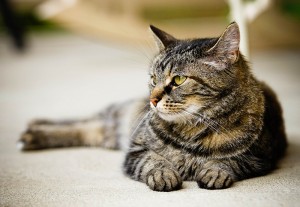 One of the most common health concerns that cats may suffer from during their lifetime is Feline Lower Urinary Tract Disease (FLUTD).
One of the most common health concerns that cats may suffer from during their lifetime is Feline Lower Urinary Tract Disease (FLUTD).
FLUTD refers to a number of conditions that affect the bladder or urethra in cats. Causes of FLUTD include;
* Feline Idiopathic Cystitis (FIC) or interstitial cystitis – this is the most common cause of FLUTD as it is the general diagnosis given if a cat presents with symptoms of FLUTD and no other cause is able to be diagnosed.
* Urolithiasis (Urinary Stones) – this is when stones, or a hard collection of minerals, are formed in the bladder. Urinary stones are usually diagnosed after an x-ray confirms their presence.
* Urethral obstruction – which is the most serious and life threatening cause of FLUTD. This is when the cats urethra becomes partially or completely blocked. The blockage can be caused by stone or a urethral plug which is made up of a combination of protein/cellular material and minerals or prostate disease in male cats can cause an obstruction. To determine if a blockage is present the vet will feel the cats abdomen and x-rays and blood tests will be taken.
* Urinary tract infection – this is more common in older cats over the age of 10 and occurs when a bacterial infection takes place in the bladder or urethra. This can be diagnosed through testing a urine sample.
There are a variety of different factors that can contribute to a cat suffering from FLUTD and it is often hard to determine the exact cause. Some risk factors include age, sex, obesity, diet, lifestyle, exercise, stress, urine concentration, urine pH and other illnesses like diabetes.
As a cat owner it is very important to know the signs of feline lower urinary tract disease as it can become quickly life threatening, particularly in the case of a urethral obstruction. If any signs or symptoms of FLUTD are seen the cat should see a veterinarian immediately so the cause can be promptly determined and treatment commenced.
Signs and Symptoms of FLUTD include;
* Frequent or abnormal urination.
* Continually visiting the litter tray
* Passing only small amounts of urine
* Straining to urinate.
* Meowing or crying out more frequently or while urinating
* Licking the genitals
* Urinating outside the litter tray
* Blood in urine
* Abdominal pain
If a cat is suffering from a blockage they are likely to show severe signs of the above symptoms as well as possible vomiting, lethargy and no appetite and should be urgently taken to a veterinarian.
Unfortunately a cat that has suffered from a lower urinary tract problem is more likely to have re-occurring issues like bladder or urethra inflammation, infections and blockages. There are a few things you can do from home to help reduce the frequency of recurring FLUTD. These things include;
* Always provide a plentiful supply of fresh, clean water
* Keep litter boxes clean
* Provide a number of accessible litter boxes in quiet, safe areas
* Try to minimize stress and changes to household routines
* If prescribed by a veterinarian specially formulated cat food should be fed. These foods have been developed to suit cats prone to urinary tract problems. There are a number of different varieties of feeds available and you should always use only what a vet has advised as each type is specifically developed for different problems.
* Regular check ups with your veterinarian are necessary as advised by your vet.
Feline lower urinary tract disease is a common problem but is also manageable. The most important thing to remember is that if you are concerned that your pet may be suffering from any form of urinary tract disease or is presenting with any signs or symptoms listed above you do need to get them to a veterinarian immediately.
Until next time,
Bec
